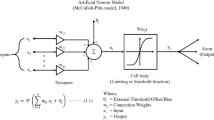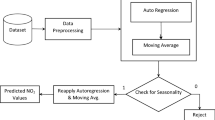Abstract
A hybrid model is proposed in this research in order to forecast concentration values of NO2 with one-hour prediction horizon in the air quality monitoring network of the Bay of Algeciras area (Spain). Air pollution is an important environmental problem these days and it requires control. However, it is not an easy task. The main problem is that air pollution data series are non-lineal and non-stationary. Thus, techniques based on regression and simple models are not able to entirely capture the phenomenon behaviour. A LASSO-ANN hybrid model is proposed. The first step has been to predict the linear part of the time-series performing a least absolute shrinkage and selection operator (LASSO) model. Later, an artificial neural network (ANN) model has been performed to predict the residual sequence, the unexplained part of the LASSO model. The chaotic residual behaviour has been smoothed using an autoregressive moving window and applying the window median. The last step has been to aggregate the predicted NO2 value and its predicted residual. The model has been validated and tested using cross-validation based on R correlation coefficient, MSE, MAE and d index of agreement, and also Friedman test and LSD test. In addition, the proposed approach has been compared to a simple ANN model. The results reveal that hybrid model presents a better performance than a multiple linear regression and also a simple ANN model. The main purpose is to develop a forecasting model capable of capturing the non-linear information of the variable and increase the accuracy of the outputs.
Access this chapter
Tax calculation will be finalised at checkout
Purchases are for personal use only
Similar content being viewed by others
References
Gong, B., Ordieres-Meré, J.: Prediction of daily maximum ozone threshold exceedances by preprocessing and ensemble artificial intelligence techniques: case study of Hong Kong. Environ. Model Softw. 84, 290–303 (2016)
Jiang, P., Li, C., Li, R., Yang, H.: An innovative hybrid air pollution early-warning system based on pollutants forecasting and Extenics evaluation. Knowl.-Based Syst. 164, 174–192 (2018)
Cabaneros, S.M.S., Calautit, J.K.S., Hughes, B.R.: Hybrid artificial neural network models for effective prediction and mitigation of urban roadside NO2 pollution. Energy Procedia 142, 3524–3530 (2017)
Cheng, S., Li, L., Chen, D., Li, J.: A neural network based ensemble approach for improving the accuracy of meteorological fields used for regional air quality modeling. J. Environ. Manag. 112, 404–414 (2012)
González-Enrique, J., Turias, I.J., Ruiz-Aguilar, J.J., Moscoso-López, J.A., Franco, L.: Spatial and meteorological relevance in NO2 estimations. A case study in the Bay of Algeciras (Spain). Stoch. Environ. Res. Risk Assess. 33, 801–815 (2019)
Zhang, Z., et al.: Evolution of surface O3 and PM2.5 concentrations and their relationships with meteorological conditions over the last decade in Beijing. Atmos. Environ. 108, 67–75 (2015)
Turias, I.J., González, F.J., Martin, M.L., Galindo, P.L.: Prediction models of CO, SPM and SO2 concentrations in the Campo de Gibraltar Region, Spain: a multiple comparison strategy. Environ. Monit. Assess. 143(1–3), 131–146 (2008)
Cisneros, M.A.P., Morán, L.J.M., Arreola, A.G.: Artificial neural networks applied in the forecast of pollutants into the Rio Santiago, based on the sample of a pollutant, by data fusion. In: 2016 IEEE 11th Conference on Industrial Electronics and Applications (ICIEA), pp. 1135–1138 (2016)
Ardalani-Farsa, M., Zolfaghari, S.: Chaotic time series prediction with residual analysis method using hybrid Elman-NARX neural networks. Neurocomputing 73(13–15), 2540–2553 (2010)
Tibshirani, R.: Regression shrinkage and selection via the lasso: a retrospective. J. R. Stat. Soc. Ser. B Stat. Methodol. 73(3), 273–282 (2011)
Hornik, K., Stinchcombe, M., White, H.: Multilayer feedforward networks are universal approximators. Neural Netw. 2(5), 359–366 (1989)
Rumelhart, D., Hinton, G., Williams, R.: Learning internal representations by error propagation. In: Parallel Distributed Processing, pp. 318–362. MIT Press, Cambridge (1986)
Acknowledgements
This work is part of the coordinated research projects TIN2014-58516-C2-1-R and TIN2014-58516-C2-2-R supported by MICINN (Ministerio de Economía y Competitividad - Spain). Monitoring data have been kindly provided by the Environmental Agency of the Andalusian Government.
Author information
Authors and Affiliations
Corresponding author
Editor information
Editors and Affiliations
Rights and permissions
Copyright information
© 2020 Springer Nature Switzerland AG
About this paper
Cite this paper
Van Roode, S., Ruiz-Aguilar, J.J., González-Enrique, J., Turias, I.J. (2020). A Hybrid Approach for Short-Term NO2 Forecasting: Case Study of Bay of Algeciras (Spain). In: Martínez Álvarez, F., Troncoso Lora, A., Sáez Muñoz, J., Quintián, H., Corchado, E. (eds) 14th International Conference on Soft Computing Models in Industrial and Environmental Applications (SOCO 2019). SOCO 2019. Advances in Intelligent Systems and Computing, vol 950. Springer, Cham. https://doi.org/10.1007/978-3-030-20055-8_18
Download citation
DOI: https://doi.org/10.1007/978-3-030-20055-8_18
Published:
Publisher Name: Springer, Cham
Print ISBN: 978-3-030-20054-1
Online ISBN: 978-3-030-20055-8
eBook Packages: Intelligent Technologies and RoboticsIntelligent Technologies and Robotics (R0)




